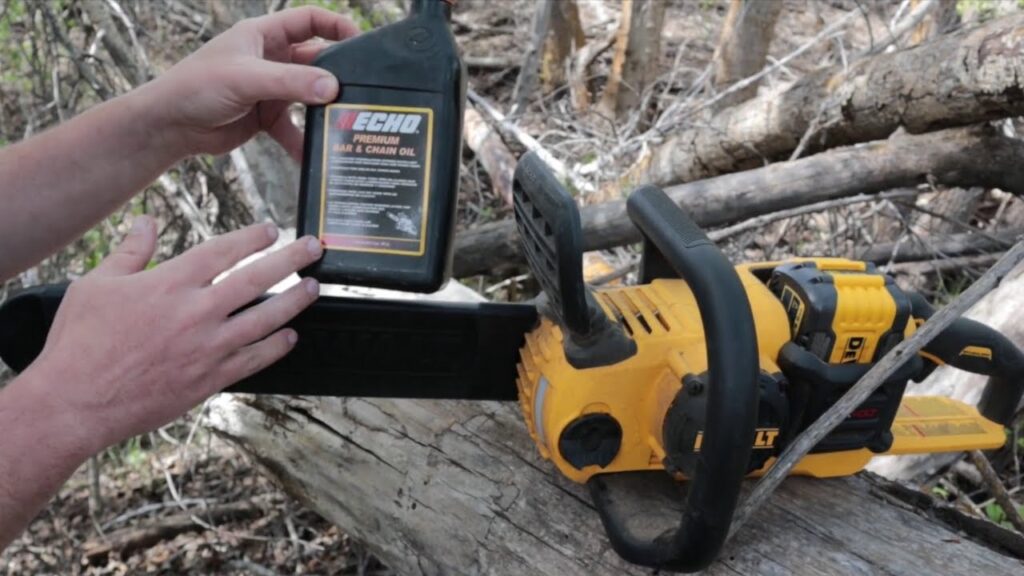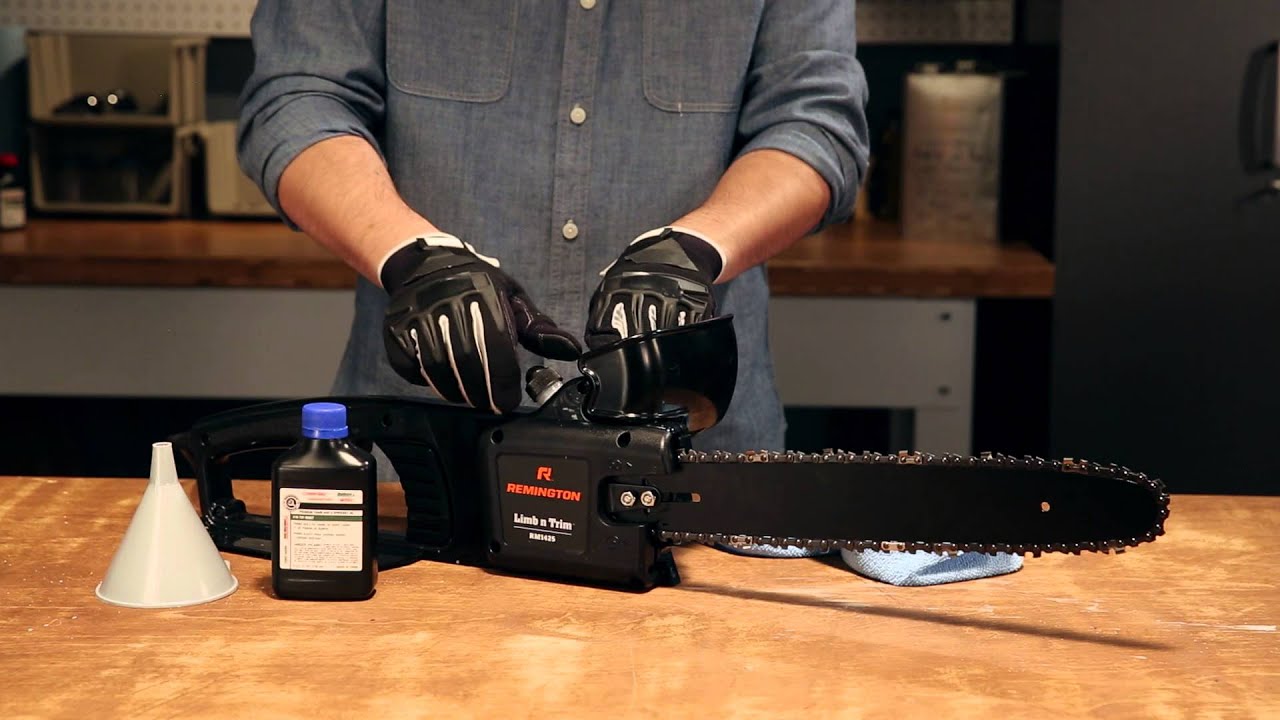Are you ready to keep your electric chainsaw running smoothly and efficiently? One crucial maintenance task you don’t want to overlook is oiling your electric chainsaw. Proper lubrication not only extends the lifespan of your tool but also ensures optimal performance when tackling your cutting tasks.
If you’re wondering how to oil an electric chainsaw like a pro, you’ve come to the right place. Grab your chainsaw and let’s dive into the world of proper lubrication to keep your electric chainsaw in top-notch shape.
Identify whether your chainsaw needs oil or not
Regularly oiling your electric chainsaw is essential to keep it running smoothly and ensure its longevity. But how do you determine if your chainsaw requires oiling?
We will examine the signs to pay special attention to that demonstrate your electric chainsaw needs oil. By recognizing these indicators, you can maintain your chainsaw’s performance and prevent potential damage.
Check the Bar and Chain:
The first step in identifying whether your electric chainsaw needs oil is to inspect the bar and chain. Look for visible signs of dryness or lack of lubrication.
A properly oiled chainsaw will have a thin oil film on the bar and chain, ensuring smooth operation. If the bar and chain appear dry or show signs of excessive wear, it indicates that you need to oil your chainsaw.
Unusual Noise and Increased Friction:
When running a chainsaw without proper lubrication, you may notice unusual noises and increased friction during operation. If you hear grinding or screeching sounds, it could be a sign that the chain is not sufficiently lubricated.

Increased friction can lead to overheating and premature chain and bar wear. In such cases, oiling the chainsaw is necessary to reduce friction, minimize noise, and prevent damage.
Difficulty in Cutting:
Another clear indication that your electric chainsaw requires oil is when you encounter difficulties during cutting. If the chainsaw struggles to make smooth, clean cuts, it may be due to insufficient lubrication.
The chain needs to glide effortlessly through the wood; proper oiling is necessary to become stiff and effective. Applying oil to the chain ensures smoother cutting performance, making your chainsaw more efficient and effective.
Excessive Sawdust and Debris Buildup:
An overworked chainsaw that needs proper lubrication may produce excessive sawdust and debris. The chain can only effectively remove sawdust with sufficient oil, leading to clogging and accumulation around the bar and chain.
If you notice a significant increase in sawdust or debris buildup, your chainsaw needs oiling. Proper lubrication will help keep the chain clean and prevent obstructions, enabling efficient cutting and reducing the risk of damage.
Finding the Right Oil for Your Electric Chainsaw
Choosing the correct oil for your electric chainsaw is crucial to ensure optimal performance and longevity of the tool. We will direct you to the easy-to-understand method to find suitable oil for your chainsaw. Selecting the right oil can provide adequate lubrication and protect your chainsaw from premature wear and damage.
Consult the Manufacturer’s Manual:
The first step in finding the suitable oil for your electric chainsaw is to refer to the manufacturer’s manual. The manual usually contains specific recommendations regarding the type of oil suitable for your chainsaw model.
Look for sections that discuss lubrication and maintenance, as they often provide detailed information on the appropriate oil. Following the manufacturer’s guidelines ensures compatibility and optimal performance.
Consider Bar and Chain Oil:
Most electric chainsaws require bar and chain oil for lubrication. Bar and chain oil is explicitly designed to adhere to the chain and bar, providing excellent lubrication and reducing friction during operation.

This type of oil is formulated with high viscosity to ensure proper flow and cling to the surfaces even at high speeds. It also offers good resistance to heat, protecting the chain and bar from excessive wear.
Avoid Using Motor Oil or Vegetable Oil:
While it may be tempting to use readily available oils such as motor or vegetable oil as a substitute for chainsaw oil, it isn’t suggested.
Engine oil is intended for gas-powered motors and has the necessary properties to lubricate chainsaw chains effectively. Vegetable oil, on the other hand, lacks the required viscosity and can cause inadequate lubrication, leading to a chainsaw.
Look for Chainsaw Bar and Chain Oil:
To find suitable oil for your electric chainsaw, visit a local hardware store or dealership. Look for chainsaw bars and chain oil specifically labelled for use in chainsaws.
These oils are readily available and formulated to meet the lubrication needs of chainsaw chains and bars. They offer superior protection, excellent adhesion, and resistance to high temperatures, ensuring smooth operation and long chain and bar life.
Consider Environmental Factors:
If you work in colder climates, you may need to choose a chainsaw bar and chain oil with low-temperature capabilities. Cold-weather oils are formulated to remain fluid in low temperatures, preventing oil thickening and ensuring proper lubrication.
Similarly, if you frequently work in hot conditions, selecting a chainsaw oil with enhanced heat resistance can provide better protection against the heat-related chain and bar damage.
Find out the oil hole in the chainsaw bar
Proper lubrication is crucial for maintaining the performance and durability of your chainsaw. One essential aspect of lubrication is ensuring that the oil hole in the chainsaw bar is correctly identified and utilized.
We will direct you to the easiest-to-understand method to find the oil hole in your chainsaw bar, allowing you to lubricate it and enhance its longevity effectively.
Consult the Manufacturer’s Manual:
The manufacturer’s manual is invaluable for locating the oil hole in your chainsaw bar. As it typically contains detailed diagrams and instructions specific to your model.
Look for sections related to bar maintenance, lubrication, or oiling system, as they often provide information on the location and maintenance of the oil hole. Following the manufacturer’s guidance ensures accurate identification and proper lubrication.
Examine the Chainsaw Bar:
Inspect the chainsaw bar carefully to locate the oil hole. The oil hole is typically situated on the side of the bar, near the base, close to the sprocket or chain tensioning mechanism. Look for a small hole or an opening allowing oil to flow onto the chain.
Sometimes, the oil hole might be marked with a symbol or text indicating its purpose. Take your time to examine the bar closely, paying attention to any visible signs or markings that may help identify the oil hole.
Clean the Bar:
If you are having difficulty locating the oil hole due to dirt, debris, or sawdust accumulation, it is essential to clean the bar first. Use a cloth or a brush to remove any debris or obstructions that may obstruct the oil hole. By clearing away the buildup, you can reveal the oil hole and ensure proper lubrication.
Utilize a Flashlight:
In some cases, the oil hole may be partially concealed or located in a position that is challenging to see with the naked eye. To overcome this, use a flashlight or a bright light source to illuminate the bar’s surface.
Shine the light from different angles and positions to highlight any indentations, holes, or markings that could indicate the oil hole. The added light can make it easier to identify the precise location.
Seek Professional Assistance:
If you have followed the above steps and still need help locating the oil hole or have concerns about performing maintenance on your chainsaw, it is advisable to seek professional assistance.
Contact a qualified chainsaw technician or the manufacturer’s customer support for guidance. They can provide specific advice or arrange for a service professional to inspect and address any concerns related to your chainsaw’s lubrication system.
Spreading Oil in Your Chainsaw: An Easy Guide
Properly spreading oil in your chainsaw ensures effective lubrication and optimal performance. By adding a couple of drops of oil and you can help distribute the oil evenly across the chain and bar by running the chainsaw. We will provide you with a step-by-step guide on effectively spreading oil in your chainsaw.

- Add a Few Drops of Oil: Remove the cap or cover from the oil port. Take your chainsaw bar and chain oil and carefully pour a few drops of oil into the port. Be mindful of filling it appropriately, as excess oil may lead to messy operations and waste.
- Replace the Cap or Cover: Once you have added the desired amount of oil, securely replace the cap or cover on the oil port. Ensure it is tightly closed to prevent any oil leakage during operation
- Start the Chainsaw: With the oil reservoir and securely placed cap, start the chainsaw following the manufacturer’s instructions. Allow the chainsaw to run at idle speed for a short duration, typically around 30 seconds to 1 minute.
- Observe the Oil Distribution: While the chainsaw runs, observe the chain and bar area to ensure the oil is evenly distributed. See signs of oil being released onto the chain, bar, and guide grooves. The oil should create a thin film, indicating proper lubrication.
- Adjust the Oil Flow (if necessary): If you notice inadequate oil distribution or excessive oil consumption during operation, consult the manufacturer’s manual for instructions on adjusting the oil flow. Some chainsaws have adjustable oil flow mechanisms that allow you to regulate the amount of oil being released onto the chain and bar.
- Regular Maintenance: Remember that proper oiling is an ongoing process. Regularly check the oil reservoir and refill it as needed. Additionally, inspect the chain and bar for signs of wear or damage, and clean any debris or sawdust buildup that may hinder effective oil distribution.

